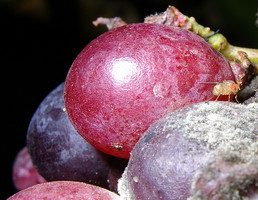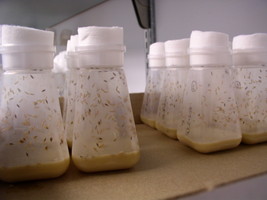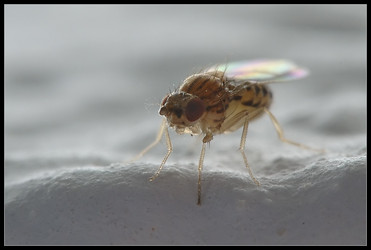Fruit Flies
Introduction
I have always been fascinated about the fruit fly. I thought it was so interesting how short their life was. When I was traveling in Egypt there were hundreds of flies around all the time. I never understood where they came from or why I didn’t see them lying around dead. So I decided to do some research about the fruit fly and find out more about its little but very important life.
Development
The developmental period of a fruit fly, which can also be called Drosophila melanogaster, is a very interesting process—it varies (like other cold-blooded species) with temperature. A fruit fly can go through a part of it’s life cycle (egg to adult) in 7 days at about 83°F. It takes about 11 days at 90°F, and 50 days at 54°F. If it’s crowded, their development time increases, but the flies tend to be smaller. Males can mate with several females while females can only mate once. Female flies lay around 400 eggs (embryos), around five at a time. The fruit fly lays the eggs into rotting fruit or other material, like decaying mushrooms and sap fluxes. The eggs will then hatch after 12-15 hours (at 80°F). The eggs are about 0.5 millimeters long. The larva then grows for about 4 days (at 80 °F) and molts twice (into 2nd- and 3rd-instar larvae). This happens at about 24 and 48 hours after the hatching of larva from the egg. They feed on the fruit. Then the larvae sums up it’s transformation and undergoes a four-day-long metamorphosis (at 80 °F), and adults emerge. Flies are triploblasts, which in short means they have 3 cell layers. Flies have bilateral symmetry, which is having a left and right side that are approximately mirror images to one another. (1)
.200a.jpg)
Drosophila melanogaster adult. © André Karwath
Adults
The size of fruit flies varies; small fruit flies are about 1/8 in (3-4 mm) long including wings. Adult small fruit flies have a feathery bristle and antennae. They also have thickened front margin wings, which intersect in two places. A mature Drosophila melanogaster has larvae about 1/4-3/8 in (7-8 mm) long; they are: eyeless, legless, and are tapered because of a large rounded rear that has a pair of dark mouth hooks at the "head" or otherwise known as the end. The color of an adult drosophila fly is a dull tan-brownish combined with yellow and black. Red is the usual color of the eyes. (3)
Environment
A fruit fly eats fresh fruits, vegetables, and fermenting liquids. If the food is getting moldy they don’t like it as much and will avoid eating it. Fruit flies are herbivores. Their habitat is actually food; the small fruit flies grow on fruit. I think they enjoy interacting with their environmental community, they eat fresh fruit—don’t have to go through rubbish to find it. They just come in contact with occasional fly swatters. The fruit fly does not have a symbiotic relationship because the fruit does not get anything out of the flies living on it. The fruit fly can also be considered a predator, because it preys on the microorganisms present on the dead fruit. (3)


Drosophila melanogaster feasting on grapes. © 2006 Max Westby
Classification
The classification of a fruit fly is a bit unique. Its kingdom (top level taxon of an organism in scientific classification) consists of animalia which are multicellualr and are capable of locomotion in their environment. The phylum consists of arthropods, which include insects, arachnids, crustaceans and others. The class of fruit flies is insecta, which are invertebrates. The order is diptera, which is known as true flies, which are insects that possess only a single pair of wings. The family of the fruit fly consists of Drosophilidae. The genus is Dropsohila which is a diverse group of flies including fruit flies, vinegar flies, wine flies, etc. The fruit fly species is melanogaster. (4)
Research Projects
The Fly development goes through a complex series of processes and stages. It’s very interesting learning about developmental processes from the biochemical and genetic levels. The stage of the fly development is identified by the time after fertilization and the events that led up to it. It goes through developmental activities that include the morphogenic process, which usually occurs after fertilization to the larval hatch. (1)
Fruit flies have been used for mutation research projects. They use fruit flies because they cost close to nothing, except for a few bananas, their entire life cycle only takes 10 days, they breed super fast, they have four chromosomes, have similar biochemical pathways to humans, and are very small so they don’t take up much space. So therefore they are an easy source to use to do experiments on.


Breeding Drosophila larvae in the laboratory. © 2005 Robert Cudmore
Using fruit flies for research has been going on for nearly a century now. It started in 1904 when Walter S. Sutton who was an American cytologist thought there might be a connection between Gregory Mendel’s 1860s research and the newly discovered chromosomes and their genes. It was actually in 1906 that they came up with the idea of using fruit flies and this was because they breed quickly and require little food. They liked the idea of fruit flies because they would reach their maturity in a few days and then they could start the research as opposed to waiting for an animal to mature. Through mutational research of fruit flies scientists have discovered that fruit flies utilize many of the same class of developmental genes that humans and other mammals do! The most well studied examples include the homeobox genes (hox genes). In fact, hox genes have been found in amlost all animals that have been looked at and have been shown to play a fundamental role in the development and patterning of the animal form.(5)
Fruit flies live year round but they’re more likely to be seen in people’s homes in the late summer and fall. This is because it starts to get cooler outside and the fruits are riper. Fruit flies are pretty much a nuisance pest, but can sometimes contaminate food and other disease-producing organisms. If people don’t enjoy having fruit flies around they can eliminate them by storing fruit in the fridge, not leaving vegetables out on the counter for a prolonged period of time and by taking out the garbage a couple times a day. If people make there own vegetables, cider or beer, they should store them in airtight containers. If there were specific areas where flies are infesting the area people would have to take precautions to get rid of them. (2)
Conclusion
So all in all fruit flies seem to be simple creatures, but I think they are rather complex. So the next time a person sees a fruit fly, maybe they can think twice about killing it and just stand in awe of how amazing and fascinating this creature truly is. That it’s one of the fastest growing species, has one of the shortest life spans, and lives off of fresh fruit.
Information on the Internet
- The Interactive Fly Works Cited 1
- Fruit Flies Works Cited 2
- Fruit Fly (small)Vinegar Fly Works Cited 3
- Wikipedia, the free encyclopedia Works Cited 4




 Go to quick links
Go to quick search
Go to navigation for this section of the ToL site
Go to detailed links for the ToL site
Go to quick links
Go to quick search
Go to navigation for this section of the ToL site
Go to detailed links for the ToL site